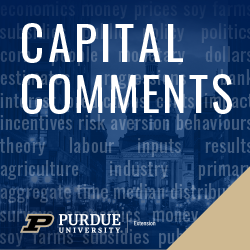Capital Comments: A Tale of Two Recessions

It was the worst of times. It was the even worse worst of times. It was the Great Recession of 2007-2009. It was the COVID Recession of 2020. How do the two recessions compare?
The Great Recession began after the economy peaked in December 2007, and then continued for 18 months through June 2009. It was the longest recession since the Great Depression.
The COVID Recession started in March 2020, after the peak in February. The end of the COVID Recession hasn’t been marked yet. Possibly it’s already over, because the economy grew in the third quarter. If the trough was in June, it will be a four-month recession, the shortest on record.
It sure doesn’t feel like the recession is over. But if a recession is when the economy is shrinking, then the last day of recession and the first day of recovery are the two worst days. Output is still down 3 percent from last year. We’re climbing out, but we’re still in the hole.
The highest monthly unemployment rate during the Great Recession was 10 percent in October 2009. That was 22 months after the economy’s peak, and four months after the recession was over. Growth was too slow to create enough jobs in those first few months of recovery. The highest unemployment rate in the COVID Recession was 14.7 percent in April, the second month of the recession. That was a sharp drop.
The industries that fell the most during the Great Recession were housing construction, business investment and consumer durable goods production. The recession started in housing, and from peak to trough, housing construction fell 36 percent. Investment in business structures and equipment fell by double digits too. That’s as usual. Businesses won’t add capacity when they can’t sell what they make from the capacity they’ve got.
Durable goods manufacturing fell 15 percent in the Great Recession. That’s also usual. When people fear for their jobs they keep buying food and paying the mortgage if they possibly can. But that new car, dishwasher, bedroom suite? Maybe later.
The COVID Recession could hardly be more different. Housing construction is up since the fourth quarter 2019. So are durable goods purchases. Business structure investment is down a lot, though equipment investment has dropped just a little. But consumer service production is down 8 percent. It never declined during the Great Recession. Services require face-to-face contact, which people avoid if they can. “Social consumption” spending is down.
Retail sales tell more of this story. Compare sales in February and September. Online sales are up. Clothing store sales are down. Grocery store sales are up. Restaurant sales are down. And the strange one: motor vehicle sales are up, but gasoline sales are down. People shop online to avoid exposure. People shop in grocery stores rather than lingering in restaurants. People buy cars to avoid public transportation. People are telecommuting, so they’re driving less.
There was a financial market panic during the Great Recession. Corporate bond interest rates spiked in October 2008, and remained high into 2009. The Standard and Poor’s 500 stock market index fell by more than half. The Federal Reserve responded by cutting its policy interest rate to near-zero, but not until December 2008.
The COVID Recession scared financial markets, too. Interest rates spiked—for just two weeks in mid-March. The Fed cut its policy interest rate to near zero right away, on March 15th. The S&P 500 index is higher now than it was in February, and interest rates are near record lows.
How do the recessions compare? The Great Recession was a long, 18-month slide. Construction and manufacturing were hit hard. Financial markets panicked, and that choked off credit. The COVID Recession was sharp but short. Social consumption spending was hit hard. Financial markets thought about panicking, but didn’t, and credit appears to be abundant.
Recovery from the Great Recession took a long time. The unemployment rate didn’t touch 5% again until September 2015, more than six years after the recession’s end.
How fast will we recover from the COVID recession? Social consumption won’t recover until we beat the virus. But once we do, perhaps we’ll have a far, far better recovery than we’ve ever had before.

